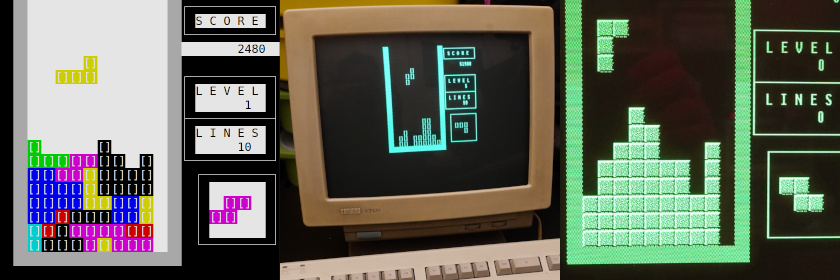Termtris is a text-based tetris game, initially written for UNIX systems and ANSI/VT100-compatible terminals, but later extended to support more terminal types, operating systems, and text-mode video hardware.
I always liked the GameBoy tetris best. So I made termtris as close as possible to that version gameplay-wise.
Termtris can run in color or monochrome mode, and can load custom character sets for graphical blocks, if there is support for that.
There are two main flavors of termtris which can be compiled from the same source tree:
-
The original UNIX version which runs on terminals, and can also be compiled for windows using a POSIX emulation layer such as msys2 or cygwin. It has been tested on multiple UNIX systems (GNU/Linux, FreeBSD, IRIX, Solaris, MacOSX), and multiple terminals (VT52, VT100, VT220, VT420, MS 6102), and terminal emulators (xterm, linux console, kermit, iTerm2).
-
The DOS version which uses the PC BIOS to access display and keyboard, but can also optionally work with the same terminals supported by the UNIX version.
- website: http://nuclear.mutantstargoat.com/sw/termtris
- source repository: https://github.com/jtsiomb/termtris
Aor left arrow moves the block left.Dor right arrow moves the block right.Sor down arrow drops the block faster.W, up arrow, or space rotates the block.- enter, tab, or
0drops the block immediately. Ppauses and unpauses the game.- backspace, or delete starts a new game.
Qor hitting escape twice, quits immediately.Hshows or hides the help panel which lists these keybindings.Rshows or hides the high score table.
Additionally on GNU/Linux systems any joystick can be used to control the game.
The first available joystick is used automatically, or you can specify a
joystick device with the -j commandline option. If you'd rather disable
joystick control, use the option -j /dev/null.
When using a joystick, even axes are mapped to left/right, Odd axes are mapped to up/down, the first four buttons rotate, and the rest of the buttons pause and unpause.
There is no way to remap the controls without changing the source code at this time.
For terminals with support for custom loadable character sets, you can instruct
termtris to use graphical blocks instead of the bracket characters with the -g
command-line argument. If TERM is set to a known supported terminal, graphical
blocks are enabled automatically, use the -T option to disable and inhibit
auto-detection.
Different terminals have different capabilities when it comes to soft character
sets. Termtris will try to detect the terminal type and choose the correct soft
font to load, but if it fails or you want to force a different terminal type,
make sure to define the TERM environent variable. If TERM is undefined, or
an unknown or unsupported terminal type, termtris will try to interrogate the
terminal itself about its capabilities.
The DOS version of termtris will automatically enable graphical blocks when it
detects an EGA or VGA/SVGA graphics card. Use -g or -T to enable or disable
it explicitly.
Copyright (C) 2019-2023 John Tsiombikas nuclear@mutantstargoat.com
This program is free software. Feel free to use, modify, and/or redistribute it under the terms of the GNU General Public License version 3, or at your option, any later version published by the Free Software Foundation. See COPYING for details.
Current release (1.9): http://nuclear.mutantstargoat.com/sw/termtris/termtris-1.9.tar.gz
Releases are also mirrored on github: https://github.com/jtsiomb/termtris/releases
Alternatively you may clone the latest version of the source code from the git repository:
git clone https://github.com/jtsiomb/termtris
Building from source is highly recommended. If however you want to try a pre-compiled binary, you might be able to find something for your system in: http://nuclear.mutantstargoat.com/sw/termtris/bin Not all releases are compiled for all platforms. Any binaries available here are provided purely for convenience. Do not open bug reports about a pre-compiled binary not running, or misbehaving on your system; compile it yourself first.
Another source of binaries, is the github automated builds. Head over to the "actions" page (https://github.com/jtsiomb/termtris/actions), choose the latest successful build for your platform, and download the binary from the "artifacts" section at the bottom.
Pre-compiled binaries might also be available in your package management system of choice, but please do not submit any bug reports without first trying to build termtris yourself from the latest git source code.
- Debian/Ubuntu/Mint:
apt-get install termtris
The latest pre-compiled DOS binary (currently 1.9) is always available at: http://nuclear.mutantstargoat.com/sw/termtris/termtris.com
There are no external dependencies. Simply type make to build, and make install if you wish to install termtris.
Default installation prefix is /usr/local. Change the first line of the
Makefile if you'd rather install somewhere else, or simply invoke the install
rule like so:
make PREFIX=/some/other/prefix install
If you don't have GNU make and GCC installed, or you'd rather use the default
make utility and C compiler on your UNIX system, you can use Makefile.sgi:
make -f Makefile.sgi
(originally included for building on SGI IRIX with MIPSPro and the native make).
To build the DOS version of termtris you'll need some version of the Watcom or OpenWatcom C compiler, and the NASM assembler:
make -f Makefile.wat
